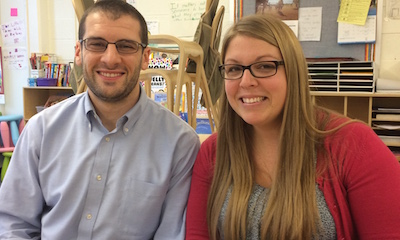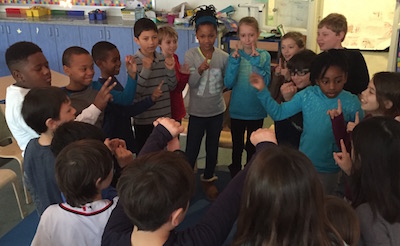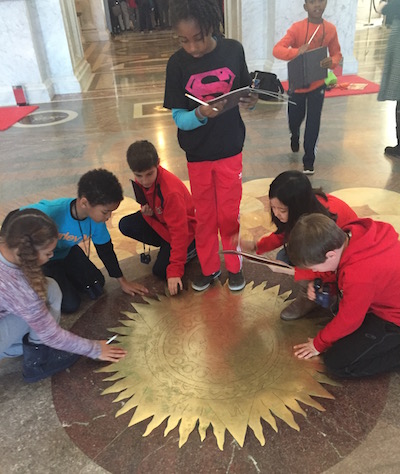
Jordan Loftis and Caitie Meehan are the new duo in charge of teaching the school’s forty 4th graders — and first ever 4th grade class at SWS.
Mr. Loftis hails from Buffalo, NY, and worked for DCPS for five years before coming to SWS to teach English Language Arts. (More about Mr. Loftis in his SWS bio.) Caitie is from Chesapeake, VA, and taught in Fairfax County for 12 years and worked as a Responsive Classroom teacher and presenter before coming to SWS. (More about Ms. Meehan in her SWS bio.) It’s the first time both have worked in a Reggio school.
Is it very different teaching in a Reggio environment?
Jordan: I’ve never had this much independence and freedom and faith in me as a professional. That flexibility doesn’t exist in a lot of different places. You really feel very comfortable, as teacher, experimenting and revising as you go along, and it’s a really supportive environment in which to do that. This is also the first year I’ve had a curriculum to work with. Here at SWS, we are using the Readers and Writers Workshop Curriculum and it’s great because it gives you all kinds of strategies and the kids can choose what works for them. We go over different strategies for making your writing stronger, like using dialogue, or zooming in on small actions, of revising ledes. It’s a menu of different strategies and kids can apply the strategies that work for them, just as adults pick and choose strategies that work for them. The goal is to create lifelong readers and writers.

Caitie: I would say in math there is more acceptance of big math projects, versus having to get through a list of standards, and constantly quizzing. Here, in this Reggio environment, we can do bigger math projects that encompass many standards, and I just check off the various standards as the kids are thinking and planning and working their way through a more complex problem. We’ve been working on fractions, for example, and I presented the kids with this problem: “22 kids went on a field trip, but they only had 17 sandwiches to go around.” They had to decide how much of each sandwich each person was going to get, so everyone would get fair share. Fairness being very important to 4th graders, this hit home for them! And because it wasn’t an easy problem (22 divided by 17), they had to do a lot of fraction work, so they covered a lot of ground.
Caitie and Jordan: Another thing that is really different about being in a Reggio environment — and we talk about this a lot — is the kids. These kids have been in a Reggio environment since they were 3 or 4. We’ve been blown away by how they solve problems, by their curiosity and wonderings, and it enhances all of our lessons. Our read-alouds are only supposed to be 15 minutes, but it often goes longer because of all their introspection and the way they share ideas and thoughts with each other, and the empathy they show towards characters in a book! This group came knowing a lot of problem solving techniques, dealing with frustration, and we just had to tailor it to their being nine, and dealing with the things that 9- and 10-year-olds deal with.

How do you hit Common Core standards in this environment?
Caitie: This year DCPS put out a list of 8 math practice standards. They are, essentially, the way we solve problems not just in math but everywhere. How we persevere when there is an issue, how we explain our reasoning. How we can focus on accuracy in order to make our work make sense. It works really well in math, and one thing I do to make sure they are hitting the common core standards is by pulling some of the more challenging questions they encounter on the computerized tests they take every few months. I put them down on paper, give the kids a chance to use the different strategies we’ve been building up, and make them more comfortable with this process. For me, the questions are hitting the common core standard, so I can see how they are doing with that particular standard. Some of the questions on these test are very challenging. My goal for anxious 4th graders (and 4th graders can get really anxious!) is to get them comfortable with seeing the questions and knowing what to do.
Jordan: As you go up, there are specific standards we have to cover. But here, because of the kids’ Reggio background, it’s so much more collaborative and discussion-based. The kids here are used to generating questions and developing plans to answer them. You do that when you are doing a project, and you do it when you are focusing on finding the theme in what you are reading. It’s the same skills, the same habits of mind, and we are helping the students apply these in specific ways.
Caitie: Also, 4th grade math is a patience game. They are picking up a lot, and sometimes I just have to be patient and wait for them to make those connections themselves instead of forcing it because it’s not going to mean as much if they don’t come to those connections on their own. And in a room of 20 kids, we’ll get maybe 10 different strategies, 8 that I’ve taught them and 2 that are, like “huh! I never would have thought that up.” And that comes right back to the Reggio approach — there is not just one way to do things, there are all kinds of ways to approach learning and express thinking.
How do you deal with the impending loss of many students next year from the SWS community, given that a good number will likely leave for Charter schools that start at 5th grade?
Jordan and Caitie: It’s hard. It’s hard for everyone. We realize that for the second half of the year it’s going to be a challenge of ours to take this beautiful Reggio environment they have been in, and all the skills they have — of being kind and honest with each other, talking through problems, being honest about their feelings — and help them build up their skills, their strength and conviction, so they will have that when they scatter. Many will be leaving for middle school, so we have to figure out how we can help them hang on to their wonder and curiosity and empathy and social skills — all things that enhance their academic skills — when they are not completely immersed in an environment that supports that. So we’ve read Wonder and Auggie and Me, books that hit a lot of those hard core life issues when you are in 5th grade. They’ve done amazing thinking around that. So I think we’ll use that thinking when we have those “what’s next” conversations in the second half of the year.

